Telegraph history in summary
At school for the summer they always asked a very heavy list of references - usually I missed no more than half, and I read the entire one in brief. “War and Peace” on five pages - what could be better ... I will tell you about the history of telegraphs in a similar genre, but the general meaning should be clear.
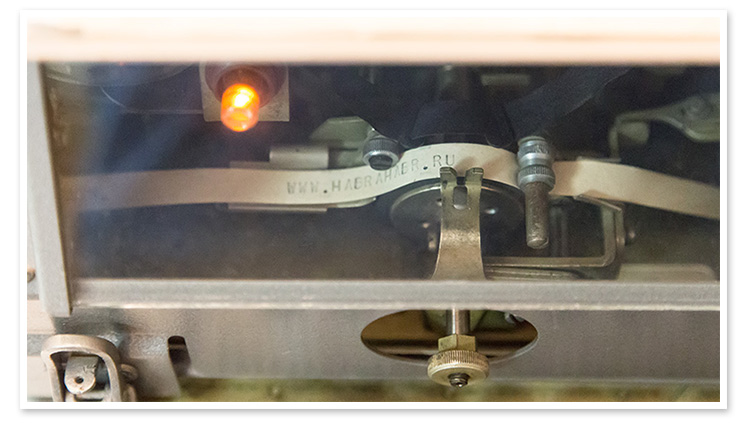
The word "Telegraph" comes from two ancient Greek words - tele (far) and grapho (writing). In the modern sense, it is simply a means of transmitting signals by wire, radio or other communication channels ... Although the first telegraphs were wireless - long before they learned to correspond and transmit any information over long distances, people learned how to tap, swink, make fires and pounding drums - all this can also be considered telegraphs.
Believe it or not, sometime in Holland, messages were transmitted (primitive) with the help of windmills, of which there were a huge number - they just stopped wings in certain positions. Perhaps it was this that once (in 1792) inspired Claude Schaf to create the first (among non-primitive) telegraph. The invention received the name "Heliograph" (optical telegraph) - as you can guess from the name, this device allows you to transmit information through sunlight, or rather, due to its reflection in the system of mirrors.
')
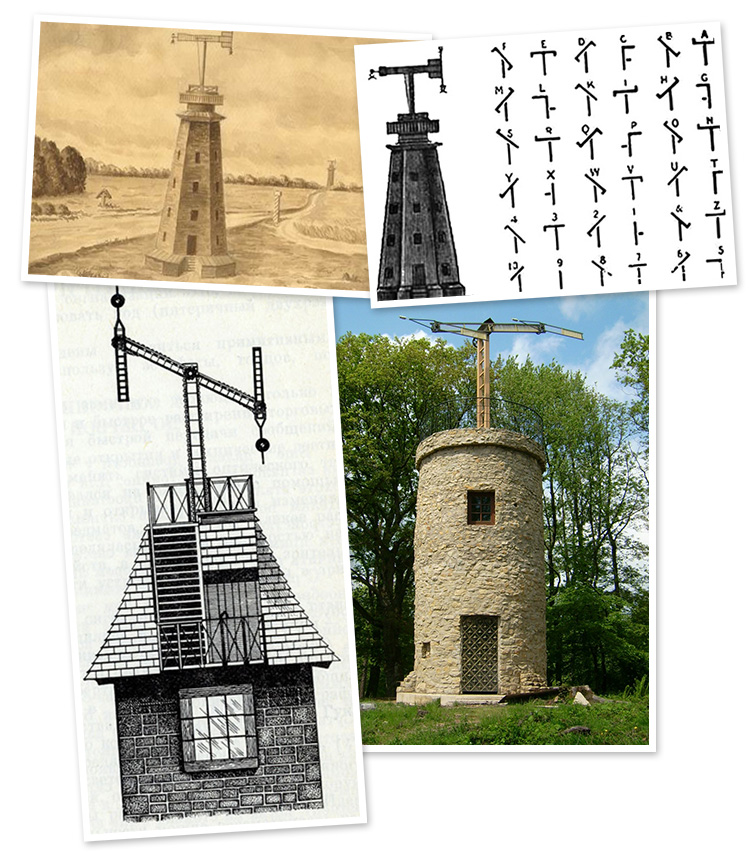
Between the cities, special towers were erected in direct line of sight from each other, on which huge articulated wings of the semaphores were installed - the telegraph operator received the message and immediately passed it on, moving the wings with levers. In addition to the installation itself, Claude invented his own character language, which allowed him to transmit messages at a speed of up to 2 words per minute. By the way, the longest line (1200 km) was built in the 19th century between St. Petersburg and Warsaw - the signal passed from end to end in 15 minutes.
Electric telegraphs became possible only when people began to study the nature of electricity more closely, that is, around the 18th century. The first article on electric telegraph appeared on the pages of a scientific journal in 1753 under the authorship of a certain “CM” - the author of the project proposed to send electric charges through numerous isolated wires connecting points A and B. The number of wires should correspond to the number of letters in the alphabet: “ Balls at the ends, the wires will electrify and attract the light bodies with the image of letters . ” Later it became known that the Scottish scientist Charles Morrison was hiding under “CM”, who, unfortunately, was not able to establish the proper operation of his device. But he acted nobly: he treated other scientists with his work and gave them an idea, and they soon offered various improvements to the scheme.

Among the first was the Geneva physicist Georg Lesage, who in 1774 built the first working electrostatic telegraph (he also proposed laying telegraph wires underground in clay pipes in 1782). All the same 24 (or 25) isolated from each other wiring, each corresponds to its own letter of the alphabet; the ends of the wiring are connected to an “electric pendulum” - by transferring a charge of electricity (then ebony sticks were still in full swing), you can make the corresponding electric pendulum of another station go out of balance. Not the fastest option (the transfer of a small phrase could take 2-3 hours), but at least it worked. After 13 years, the Lesage telegraph was perfected by the physicist Lomon, who reduced the number of wiring needed to one.
Electric telegraphy began to develop intensively, but really brilliant results gave only when it began to use not static electricity, but galvanic current - food for thought in this direction for the first time (in 1800) threw Alessandro Giuseppe Antonio Anastasio Gerolamo Umberto Volta. The first deflecting effect of the galvanic current on the magnetic needle in 1802 was noticed by the Italian scientist Romanesi, and already in 1809 the first telegraph invented by the chemical actions of the current was invented by Munich academician Sömmering.

Later, in the process of creating the telegraph, the Russian scientist, namely Pavel Lvovich Shilling, decided to take part - in 1832 he became the creator of the first electromagnetic telegraph (and later - also the original code for the work). The design of the fetus of his efforts was this: five magnetic arrows, suspended on silk threads, moved inside the "multipliers" (coils with a large number of turns of wire). Depending on the direction of the current, the magnetic needle went in one direction or another, and together with the arrow a small cardboard disc was rotated. Using the two directions of the current and the original code (made up of combinations of the disc deflection of six multipliers), it was possible to transmit all the letters of the alphabet and even numbers.
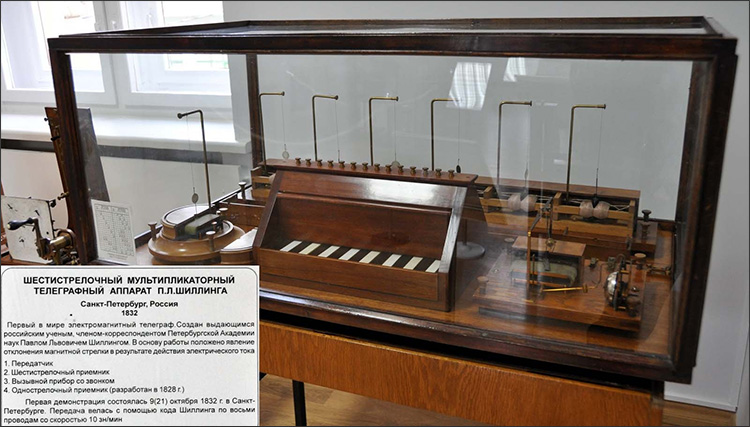
Schilling was asked to make a telegraph line between Kronstadt and St. Petersburg, but in 1837 he died, and the project froze. Only after almost 20 years, another scientist, Boris Semenovich Yakobi, resumed it - among other things, he began to think about how to record the received signals, began working on the project of the writing telegraph. The task was completed - the conditional icons were written down by a pencil attached to the electromagnet anchor.
Also, Karl Gauss and Wilhelm Weber (Germany, 1833) and Cook and Wheatstone (Great Britain, 1837) invented their electromagnetic telegraphs (or even the “language” for them). And, I didn’t forget about Samyuil Morse, although I already told about him in detail . In general, we finally learned how to transmit an electromagnetic signal over long distances. It started - first simple messages, then the correspondent networks began to telegraph news for many newspapers, then whole telegraph agencies appeared.
The problem was the transfer of information between continents - how to stretch more than 3000 km (from Europe to America) wires across the Atlantic? Surprisingly, this is exactly what they decided to do. The initiator was Cyrus West Field - one of the founders of the Atlantic Telegraph Company, who arranged hardpati for the local oligarchs and convinced them to sponsor the project. The result was a “tangle” of a cable weighing 3,000 tons (consisting of 530,000 kilometers of copper wire), which by August 5, 1858, successfully unwound across the Atlantic Ocean the largest warships of Great Britain and the USA at that time — Agamemnon and Niagara. . Later, however, the cable broke - not the first time, but it was repaired.
The inconvenience of the Morse telegraph was that only specialists could decipher its code, while it was completely incomprehensible to ordinary people. Therefore, in the following years, many inventors worked to create an apparatus registering the message text itself, and not just the telegraph code. The most famous among them was the Yuze direct printing apparatus:
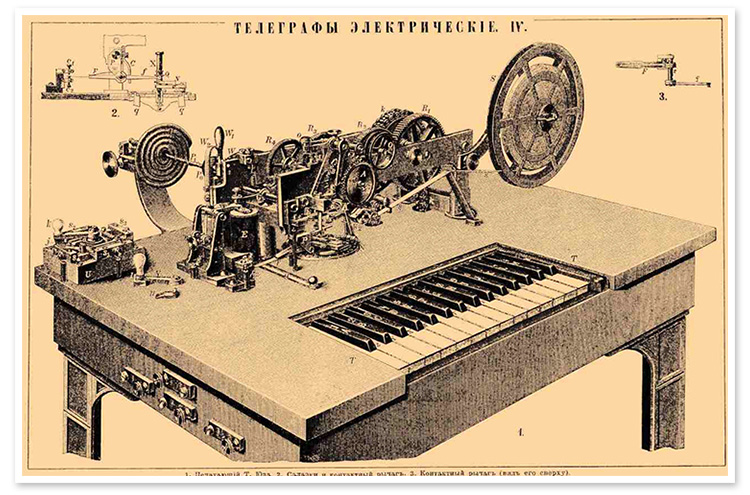
Thomas Edison decided to partially mechanize (facilitate) the work of telegraph operators — he proposed to completely exclude human participation by writing telegrams on punched tape.
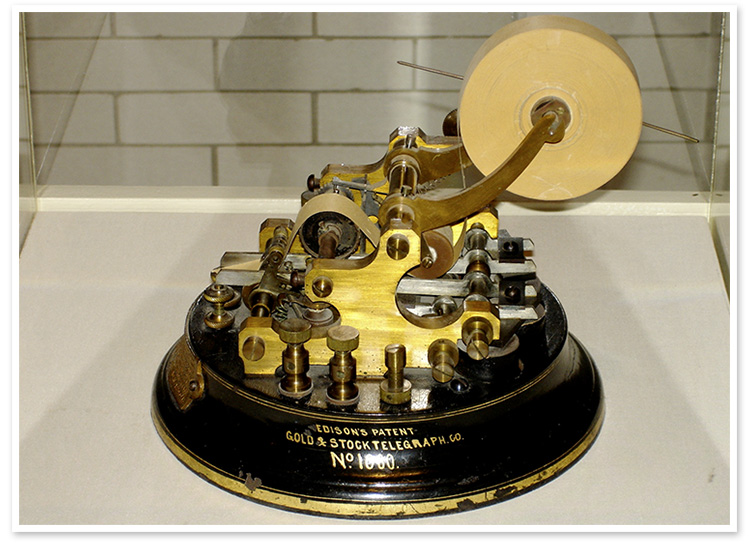
The tape was made on the reperformer - a device for punching holes in a paper tape in accordance with the telegraph code signs received from a telegraph transmitter.
The reperforator received telegrams at transit telegraph stations, and then transmitted them automatically using a transmitter, thereby eliminating the time-consuming manual processing of transit telegrams (tape sticker with characters printed on it on the form and the subsequent transfer of all characters manually from the keyboard). There were repertransmitters - devices for receiving and transmitting telegrams that perform the functions of a reperformer and transmitter at the same time.
In 1843, there were faxes (few people know that they appeared before the phone) - they came up with their Scottish watchmaker, Alexander Bein. His device (which he himself called Bane's telegraph) was capable of transmitting copies of not only text, but also images (albeit in a disgusting quality) for long distances. In 1855, his invention improved Giovanni Caselli, refining the quality of image transmission.
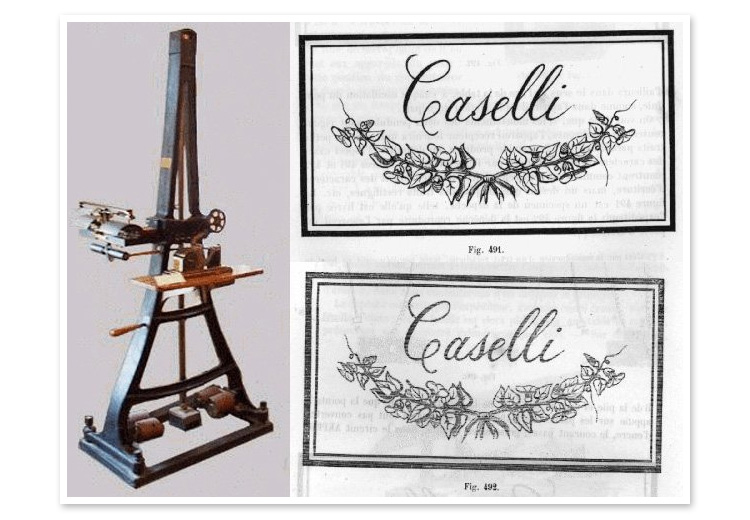
True, the process was quite labor-intensive, judge for yourself: the original image had to be transferred to a special lead foil, which was “scanned” by a special pen attached to the pendulum. The dark and light areas of the image were transmitted in the form of electrical pulses and were reproduced on the receiving device by another pendulum, which was “painted” on special wetted paper impregnated with a solution of ferro-sintered potassium. The device was called Pantelegraf and later enjoyed great popularity around the world (including in Russia).
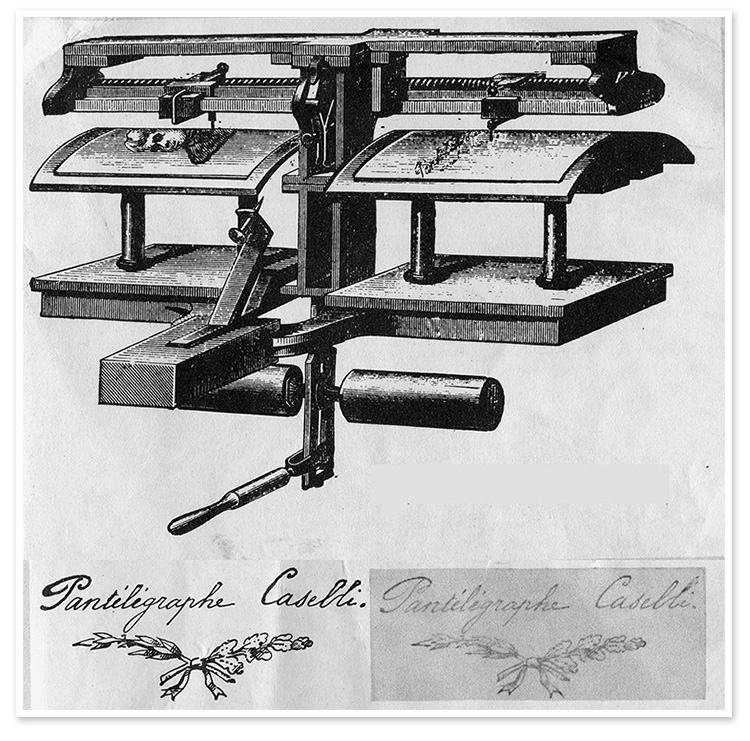
In 1872, the French inventor Jean-Maurice Emile Bodo designed his multiple-action telegraph apparatus - he had the opportunity to send two or more messages one way on one wire. The device Bodo and created by its principle were called start-stop.
But besides the device itself, the inventor also invented a very successful telegraph code (Bodo Code), which later gained great popularity and received the name International Telegraph Code No. 1 (ITA1). Further modifications to the construction of the start-stop telegraph apparatus led to the creation of teleprinters (teletypes), and in honor of the scientist the unit of information transmission rate was named baud.

In 1930, a start-stop telegraph with a telephone-type dial (teletype) appeared. Such a device, among other things, allowed to personalize the subscribers of the telegraph network and carry out their quick connection. In the future, such devices began to be called "telex" (from the words "telegraph" and "exchange").
In our time, telegraphs in many countries have been abandoned as a morally obsolete way of communication, although it is still used in Russia. On the other hand, the same traffic light can also be considered to some extent as a telegraph, and it is already used at almost every intersection. So wait to write off the old men from the accounts;)
For the period from 1753 to 1839, there are about 50 different systems in the history of telegraph - some of them remained on paper, but there were some that became the foundation of modern telegraphy. As time went on, the technology and appearance of the devices changed, but the principle of operation remained the same.
What now? Inexpensive SMS messages are slowly disappearing - they are being replaced by all sorts of free solutions like iMessage / WhatsApp / Viber / Telegram and all kinds of skype Skype. You can write the message “ 22:22 - make a wish ” and be sure that the person (possibly on the other side of the globe) will most likely even have time to guess it. However, you are no longer small and you understand everything yourself ... better try to predict what will happen with the transfer of information in the future, after a similar length of time?

Photo reports from all museums (with all telegraphs) will be published a little later on the pages of our “historical” special project , but for now you can read:
» Anatomy of a mast connection
» About Morse Code
» The history of mail development
» LTE in St. Petersburg
» Overview of LTE Devices
! important: The article does not pretend to the completeness and accuracy of all data.

The word "Telegraph" comes from two ancient Greek words - tele (far) and grapho (writing). In the modern sense, it is simply a means of transmitting signals by wire, radio or other communication channels ... Although the first telegraphs were wireless - long before they learned to correspond and transmit any information over long distances, people learned how to tap, swink, make fires and pounding drums - all this can also be considered telegraphs.
Believe it or not, sometime in Holland, messages were transmitted (primitive) with the help of windmills, of which there were a huge number - they just stopped wings in certain positions. Perhaps it was this that once (in 1792) inspired Claude Schaf to create the first (among non-primitive) telegraph. The invention received the name "Heliograph" (optical telegraph) - as you can guess from the name, this device allows you to transmit information through sunlight, or rather, due to its reflection in the system of mirrors.
')

Between the cities, special towers were erected in direct line of sight from each other, on which huge articulated wings of the semaphores were installed - the telegraph operator received the message and immediately passed it on, moving the wings with levers. In addition to the installation itself, Claude invented his own character language, which allowed him to transmit messages at a speed of up to 2 words per minute. By the way, the longest line (1200 km) was built in the 19th century between St. Petersburg and Warsaw - the signal passed from end to end in 15 minutes.
| While in prison, many prisoners still have the opportunity to stay in touch - high technology even went there. Previously, quite often messages were transmitted by knocking: using a symbol table (from 6 columns and 6 lines), first a column was tapped, and then a string of the desired character. And then the "dash" from Morse code to "tap" is much more difficult than the "point";) |

Among the first was the Geneva physicist Georg Lesage, who in 1774 built the first working electrostatic telegraph (he also proposed laying telegraph wires underground in clay pipes in 1782). All the same 24 (or 25) isolated from each other wiring, each corresponds to its own letter of the alphabet; the ends of the wiring are connected to an “electric pendulum” - by transferring a charge of electricity (then ebony sticks were still in full swing), you can make the corresponding electric pendulum of another station go out of balance. Not the fastest option (the transfer of a small phrase could take 2-3 hours), but at least it worked. After 13 years, the Lesage telegraph was perfected by the physicist Lomon, who reduced the number of wiring needed to one.
Electric telegraphy began to develop intensively, but really brilliant results gave only when it began to use not static electricity, but galvanic current - food for thought in this direction for the first time (in 1800) threw Alessandro Giuseppe Antonio Anastasio Gerolamo Umberto Volta. The first deflecting effect of the galvanic current on the magnetic needle in 1802 was noticed by the Italian scientist Romanesi, and already in 1809 the first telegraph invented by the chemical actions of the current was invented by Munich academician Sömmering.

Later, in the process of creating the telegraph, the Russian scientist, namely Pavel Lvovich Shilling, decided to take part - in 1832 he became the creator of the first electromagnetic telegraph (and later - also the original code for the work). The design of the fetus of his efforts was this: five magnetic arrows, suspended on silk threads, moved inside the "multipliers" (coils with a large number of turns of wire). Depending on the direction of the current, the magnetic needle went in one direction or another, and together with the arrow a small cardboard disc was rotated. Using the two directions of the current and the original code (made up of combinations of the disc deflection of six multipliers), it was possible to transmit all the letters of the alphabet and even numbers.

Schilling was asked to make a telegraph line between Kronstadt and St. Petersburg, but in 1837 he died, and the project froze. Only after almost 20 years, another scientist, Boris Semenovich Yakobi, resumed it - among other things, he began to think about how to record the received signals, began working on the project of the writing telegraph. The task was completed - the conditional icons were written down by a pencil attached to the electromagnet anchor.
Also, Karl Gauss and Wilhelm Weber (Germany, 1833) and Cook and Wheatstone (Great Britain, 1837) invented their electromagnetic telegraphs (or even the “language” for them). And, I didn’t forget about Samyuil Morse, although I already told about him in detail . In general, we finally learned how to transmit an electromagnetic signal over long distances. It started - first simple messages, then the correspondent networks began to telegraph news for many newspapers, then whole telegraph agencies appeared.
The problem was the transfer of information between continents - how to stretch more than 3000 km (from Europe to America) wires across the Atlantic? Surprisingly, this is exactly what they decided to do. The initiator was Cyrus West Field - one of the founders of the Atlantic Telegraph Company, who arranged hardpati for the local oligarchs and convinced them to sponsor the project. The result was a “tangle” of a cable weighing 3,000 tons (consisting of 530,000 kilometers of copper wire), which by August 5, 1858, successfully unwound across the Atlantic Ocean the largest warships of Great Britain and the USA at that time — Agamemnon and Niagara. . Later, however, the cable broke - not the first time, but it was repaired.
The inconvenience of the Morse telegraph was that only specialists could decipher its code, while it was completely incomprehensible to ordinary people. Therefore, in the following years, many inventors worked to create an apparatus registering the message text itself, and not just the telegraph code. The most famous among them was the Yuze direct printing apparatus:

Thomas Edison decided to partially mechanize (facilitate) the work of telegraph operators — he proposed to completely exclude human participation by writing telegrams on punched tape.

The tape was made on the reperformer - a device for punching holes in a paper tape in accordance with the telegraph code signs received from a telegraph transmitter.
The reperforator received telegrams at transit telegraph stations, and then transmitted them automatically using a transmitter, thereby eliminating the time-consuming manual processing of transit telegrams (tape sticker with characters printed on it on the form and the subsequent transfer of all characters manually from the keyboard). There were repertransmitters - devices for receiving and transmitting telegrams that perform the functions of a reperformer and transmitter at the same time.
In 1843, there were faxes (few people know that they appeared before the phone) - they came up with their Scottish watchmaker, Alexander Bein. His device (which he himself called Bane's telegraph) was capable of transmitting copies of not only text, but also images (albeit in a disgusting quality) for long distances. In 1855, his invention improved Giovanni Caselli, refining the quality of image transmission.

True, the process was quite labor-intensive, judge for yourself: the original image had to be transferred to a special lead foil, which was “scanned” by a special pen attached to the pendulum. The dark and light areas of the image were transmitted in the form of electrical pulses and were reproduced on the receiving device by another pendulum, which was “painted” on special wetted paper impregnated with a solution of ferro-sintered potassium. The device was called Pantelegraf and later enjoyed great popularity around the world (including in Russia).

In 1872, the French inventor Jean-Maurice Emile Bodo designed his multiple-action telegraph apparatus - he had the opportunity to send two or more messages one way on one wire. The device Bodo and created by its principle were called start-stop.
But besides the device itself, the inventor also invented a very successful telegraph code (Bodo Code), which later gained great popularity and received the name International Telegraph Code No. 1 (ITA1). Further modifications to the construction of the start-stop telegraph apparatus led to the creation of teleprinters (teletypes), and in honor of the scientist the unit of information transmission rate was named baud.

In 1930, a start-stop telegraph with a telephone-type dial (teletype) appeared. Such a device, among other things, allowed to personalize the subscribers of the telegraph network and carry out their quick connection. In the future, such devices began to be called "telex" (from the words "telegraph" and "exchange").
In our time, telegraphs in many countries have been abandoned as a morally obsolete way of communication, although it is still used in Russia. On the other hand, the same traffic light can also be considered to some extent as a telegraph, and it is already used at almost every intersection. So wait to write off the old men from the accounts;)
For the period from 1753 to 1839, there are about 50 different systems in the history of telegraph - some of them remained on paper, but there were some that became the foundation of modern telegraphy. As time went on, the technology and appearance of the devices changed, but the principle of operation remained the same.
What now? Inexpensive SMS messages are slowly disappearing - they are being replaced by all sorts of free solutions like iMessage / WhatsApp / Viber / Telegram and all kinds of skype Skype. You can write the message “ 22:22 - make a wish ” and be sure that the person (possibly on the other side of the globe) will most likely even have time to guess it. However, you are no longer small and you understand everything yourself ... better try to predict what will happen with the transfer of information in the future, after a similar length of time?

Photo reports from all museums (with all telegraphs) will be published a little later on the pages of our “historical” special project , but for now you can read:
» Anatomy of a mast connection
» About Morse Code
» The history of mail development
» LTE in St. Petersburg
» Overview of LTE Devices
! important: The article does not pretend to the completeness and accuracy of all data.
Source: https://habr.com/ru/post/193538/
All Articles